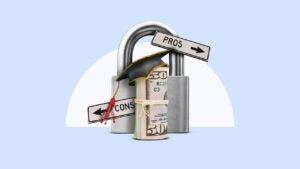What is the difference between federal and private student loans?

Key takeaways
- Federal student loans are offered by the federal government and are generally preferred over private student loans due to the unique benefits and protections they offer to borrowers.
- Private student loans typically require a credit check and may have higher interest rates, but they can be a good option if federal loans are not enough to cover educational costs.
- Some borrowers may need to take out a mix of both federal and private loans to cover their educational costs.
- It's important to carefully consider your financial situation and repayment options when choosing between federal and private student loans.
Federal and private student loans are two options that students can use to pay for college when other forms of aid fall short. While federal loans are only available through the federal government, private student loans can come from other lenders. It’s important to choose between federal vs. private student loans, as each has different interest rates, repayment terms, hardship options and fees.
In most cases, federal student loans are preferable because of the benefits they come with. But if you’ve maxed out your federal loans, it may be worth considering private student loans.
Federal vs. private student loans at a glance
| Federal student loans | Private student loans | |
|---|---|---|
| Interest rates | 6.53% to 9.08% fixed |
|
| Loan terms | Standard term is 10 years | 5 to 20 years |
| Loan amounts |
|
Up to 100% total cost of attendance |
| Where to apply | FAFSA form | Lender websites |
| Main benefits | Income-driven repayment plans, loan forgiveness options, extended deferment, forbearance and no credit checks (except for PLUS loans) | Low starting rates, no origination fees in most cases, different repayment options |
| Main drawbacks | Higher rates for good-credit borrowers, no variable rates | High rate caps, few borrower protections |
| Who is it best for | Most borrowers | Borrowers with extremely good credit who plan to pay off their loans quickly |
Rates for federal student loans are fixed and tend to be lower than private student loan rates. Federal student loans are known for their loan forgiveness options. However, federal student loans may have lower loan amounts than private loans.
Federal student loans
Federal student loans are educational loans that are available through the U.S. Department of Education. For each type of loan, the interest rate is the same for all borrowers. Federal loans also come with a variety of benefits that can make your repayment plan more affordable. That said, they are almost always the best form of financing to cover higher education costs if you qualify.
There are a few main types of federal student loans:
- Direct Subsidized Loans: These are available for undergraduate students with financial need, and they cover all accrued interest while you’re in school and during deferment and grace periods.
- Direct Unsubsidized Loans: These don’t cover your interest, but they’re available for both undergraduate and graduate students, regardless of financial need.
- Direct PLUS Loans: PLUS Loans are offered to graduate students and parents of dependent undergraduate students, and they’re the only type that doesn’t have a dollar-amount cap on how much you can borrow. The cap is based on the cost of attendance minus other financial aid you receive.
Federal student loans come with an assortment of repayment plans and other benefits, making them the preferred option if you’re eligible for this form of financing.
Benefits of federal student loans
Federal student loans have several benefits when compared to private student loans.
- Access to student loan forgiveness: Federal student loans offer access to different loan forgiveness programs, such as Public Service Loan Forgiveness (PSLF) and Teacher Loan Forgiveness. If you qualify for any of these programs, you could end up having tens of thousands of dollars in student loan debt forgiven once you meet the requirements.
- Access to income-driven repayment plans: The Department of Education offers several income-driven repayment plans, which can reduce your monthly payment to as little as 10 percent of your discretionary income. If you struggle to make your monthly payments, these plans can be a huge lifesaver.
- Few to no credit requirements: Most federal student loans don’t require a credit check at all. With Direct PLUS Loans, a credit check is used only to determine if you have certain negative items on your credit history, such as bankruptcy. If you haven’t had the chance to build a credit history, you will still qualify for federal loans.
- Discharge in the event of loss or disability: If you become permanently disabled, your federal student loan balance is automatically discharged. Loan discharge also occurs in the event of the student’s or the parent’s death (if they took a parent PLUS loan).
- Generally cheaper: For most students, federal student loans are likely cheaper than private student loans. This is especially true for undergraduate students who don’t have a stable source of income or a long credit history.
Drawbacks of federal student loans
Although there are some clear benefits to using federal loans, there are also some potential pitfalls to watch out for.
- Upfront fees: The federal government charges an upfront loan fee on all of its loan products. The fee is relatively low for undergraduate students but high for graduate and professional students, as well as for parents.
- Loan limits: Undergraduate students are limited in how much they can borrow, which may require them to ultimately turn to private student loans to bridge the gap.
- No choice of servicer: When you apply for federal student loans, the Department of Education assigns a loan servicer to you automatically. If you have a bad experience, you can consolidate your loans with another servicer, but the consolidation process can impact your access to certain benefits and protections.
Private student loans
Private student loans are educational loans offered by private lenders, like banks, credit unions and online companies. They require a credit check, and your approval and loan terms are dependent on your creditworthiness. It may be challenging for many students to get approved for private loans independently, but applying with a co-signer may improve the chances.
Private student loans offer competitive rates for creditworthy borrowers. Still, the cost savings may not outweigh the benefits offered by federal student loans.
Benefits of private student loans
Although it’s best for most students to start with federal student loans, there are some advantages to using private loans if necessary.
- Higher loan amounts: Loan limits can vary from lender to lender, but you can generally get up to the total cost of attendance, giving you more borrowing power than with the federal government.
- Chance for low interest rates: If you’re a graduate or professional student or a parent, it is possible to get a lower interest rate through a private lender than through the federal government if you have excellent credit.
- No upfront fees: Private lenders typically don’t charge upfront loan fees on private student loans, giving you savings right off the bat.
- Loan terms are more flexible: The standard term for a federal student loan is 10 years, whereas private terms may be five to 20 years.
Drawbacks of private student loans
Before taking out a private student loan, consider some of the downsides.
- Lack of protections: Private lenders don’t offer student loan forgiveness programs, and most of them don’t offer income-driven repayment plans. You may be able to get on a forbearance plan if you end up struggling financially, but options for lowering your monthly payment on a permanent basis are scarce.
- High interest rates for most: Because private loans require a credit check, people with no credit history or a low credit score may end up with a more expensive loan than what the federal government offers — and that’s if you qualify for a private loan in the first place.
- Have to search for your own loans: You can apply for a federal student loan right through your school’s FAFSA application. You need to find private loans through lender websites.
Federal vs. private loan: What type of student loan is best for me?
Whether you should get a federal or private student loan — or a mix of both — depends on your unique financial situation. Still, federal student loans are generally the best starting point for most college students and their parents. These loans come with protections and benefits, like fixed interest rates, subsidies and repayment programs, that can’t be matched by private lenders. However, there are a few instances when you should consider private student loans.
For example, if you’ve exhausted the federal student loan limit, private loans could finance the remainder of your education. And if you’re a graduate or professional college student or a parent facing higher interest rates on federal loans, it might not hurt to shop around and compare rates with various private lenders to determine if you can get a better offer.
Ultimately, the best student loan for you comes down to your financial health, the amount you need to borrow for school and how quickly you anticipate paying back the loan. It’s equally important to consider borrowing costs, along with the repayment options available to you.
If you qualify for a low interest rate and can repay your loan soon, a private student loan may be best. If you’d like to take advantage of income-driven repayment plans, extensive deferment programs and potential loan forgiveness, a federal student loan is the best option.
Bottom line
When it comes to financing your education, federal and private student loans are two options that may be worth considering. While federal loans may have lower interest rates and various benefits, private loans can be viable if you have exhausted your federal loan limit. Consider your financial situation and the repayment options before choosing between federal and private loans.
As you weigh your options, remember to compare rates and terms from different lenders to find the best option for you. If you take out a mix of federal and private loans, track the different loan details and work with your loan servicers accordingly.
Frequently asked questions
-
Parents and students can take out private and federal student loans at the same time. In fact, many borrowers have some of both. Dependent students, for instance, can take out only $5,500 in federal student loans in their first year of college, which may fall well short of their total educational costs. In this scenario, taking out a private loan and a federal loan may be the only way to cover those costs. If you do take out a mix of both federal and private loans, be aware that some of your loan details may look similar; several student loan servicers manage both federal and private loans, so you may work with the same servicer for two different types of loans.
-
Federal loans are the best and first option for many, as there are no credit checks (with the exception of PLUS loans). So, a lower credit score or little or no credit history doesn’t automatically make you ineligible for funding. For borrowers with excellent credit or a co-borrower, it may be possible to find a lower interest rate with private student loans. Students who have hit the borrowing limit for federal student loans, or who may not be eligible for federal loans, may also find solutions with private loans.
-
Federal loan denial can happen for a number of reasons, but there are still options for financing a higher education. Check with your institution’s financial aid office to see if you are eligible for grants or scholarships to help with costs. In addition, you may still be eligible for private student loans, which you can apply for separately.
-
To determine if your student loans are federal or private, check the Federal Student Aid website using your FSA ID. If they’re listed, they’re federal. If not, review your loan statements to see if they mention a federal program, or contact your loan servicer. For private loans, check your credit report to see all listed debts and lenders.








